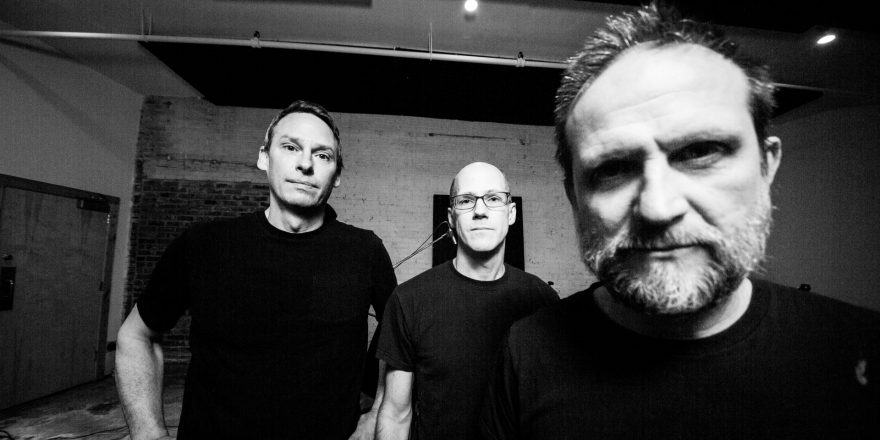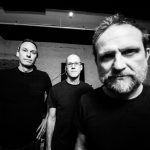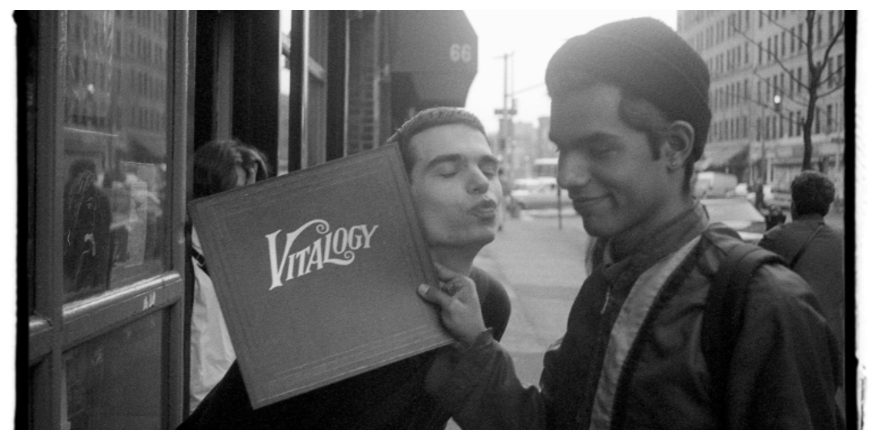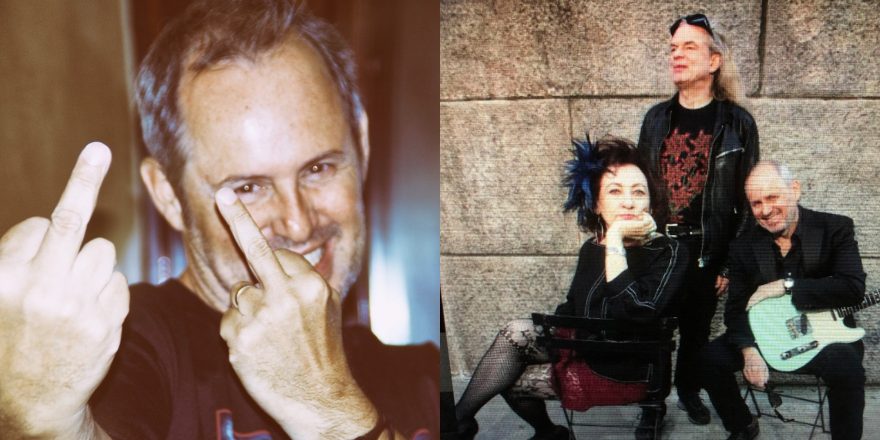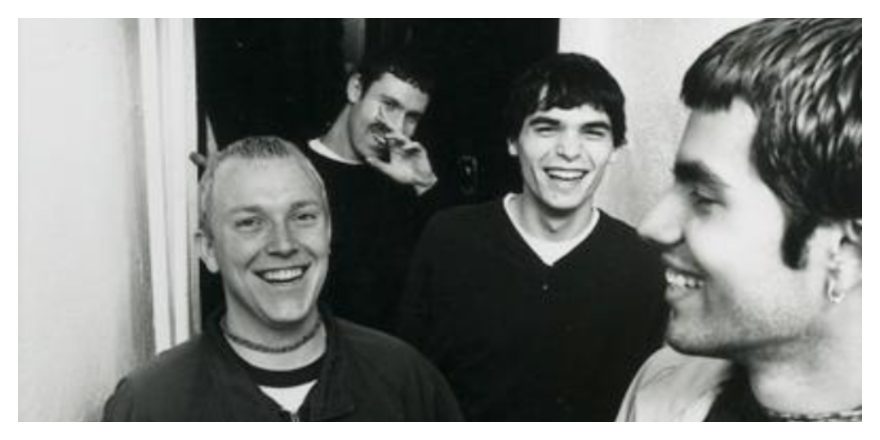Fast forward western burnt into stone — Thousand-mile-staring right through the bone.
I don’t know about you, but I can’t sit down with a stack of old VHS tour tapes of my ‘90s post-punk emo rock band GIANTS CHAIR without thinking about my unease with nostalgia. This is a band that hasn’t made a record — scarcely even played — in the last 23 years… but a band that, nevertheless, has somehow found itself with a new record to be released on December 6, 2019. Like one of my early songwriter heroes, Bob Dylan, I don’t want to look back. I don’t want to tempt my mid-life fate getting wistful or woeful about the “good ‘ol tour days.” But I’m sitting here with these tapes whirring in this borrowed TV/VCR combo because, after all these years, this band is desperate to find some footage to help us pull together some kind of music video by the end of this adult work week. So, here I am at 48. Faced, literally, with myself believing in myself and this same old, well… young, ‘90s emo rock band — at 25 years of age, 23 years ago and now. To quote a more-recent songwriting hero, David St. Hubbins, as he considers what his epitaph should be… “And why not?”
When I moved to Kansas City at 18 from rural St. James, Missouri in 1989 for art school, I fell in with a rough crowd — the local independent rock scene. I had been writing bad folk and rock songs since picking up the guitar at 14. While I had some familiarity with punk bands like Fear, Black Flag, Circle Jerks, and Dead Kennedys thanks to the Repo Man movie soundtrack and my highschool skateboard buddies from the college town 10 miles down the road, I hadn’t really heard of any of the bands my new Kansas City peers were into. Fugazi, Die Kreuzen, Skin Yard, Nirvana, Gang Of Four, etc. And it wasn’t until I heard bands like Pitchfork, Quicksand, Jawbox, and No Means No that I started to really get what these new-to-me sounds were about. While I still love my early favorite college-alt “soft rock” bands like Psychedelic Furs, Simple Minds, Big Country, and early U2, I came to realize they were, by the time I’d ever even heard of them in small-town Missouri, really less-vital, highly-produced representations of themselves. By the new “punk” standards I was honing in on (thanks mostly to the record collection of my, by then, college roommate and Giants Chair bandmate, Byron Collum) for the first time I was really questioning musical integrity and authenticity. And I was thinking critically about all this crazy new music and its effect on me. Also, now, I was seeing these bands — and my friends’ bands — live, often on the same show. This live music experience really sealed the deal for me as I became more and more influenced, face-first, by post-punk rock in Kansas City in the early ’90s. I’d always been such a nice boy, but there was so much in the viscerality and urgency of this music that was obliterating all my given notions of vocal expression, melody, and rhythm. And doing it so loudly I could feel my ego — the one that had me thinking I somehow knew what real music was — melting away.
Part of this musical awakening for me was about starting to understand the nature of inspiration, influence, and what was “real” or authentic for me in music that I loved. Who was I trying to be? What before had been the novel noise of “punk rock” was becoming the soundtrack for me questioning almost every assumption I’d brought from the country to the city. I guess my rock band Giants Chair started when I met bass player Byron that fall of 1989 at the Kansas City Art Institute. We played acoustic music together in the dorm that day. I still remember the afternoon sunlight in that room. There were a few band iterations for Byron and me in the four years to follow — some requiring us to drive two to four hours in my succession of jalopy vans to get together with the other guys — guys I had played with in high school who were now at college in different parts of the state. These were mostly just weekend practice trips with the occasional show, but damned if we weren’t “on the road” — getting REAL. After all this scuffling, we would ultimately opt for a move to Byron’s hometown of Green Bay, WI in fall of 1993 to play with Paul Ackerman, a high school friend of Byron’s on drums. People might be surprised to learn that Green Bay had an incredibly vibrant punk scene in the late ‘80s and much of the ‘90s — thanks to our good old friend and concert promoter, Rich Pluger. I’ve benefited immeasurably, if indirectly, from the Green Bay scene that brought up Byron and Paul. The band, named Giants Chair after a rock formation in the woods of my Missouri hometown’s park, really happened in Green Bay as we got our heads around what could feel together. Then we relocated back to Kansas City the following spring with a 7” single on Caulfield Records.
DIY, punk, indie, any of it, at its core, seems to be about seeking — or hoping for — authenticity. Authentic expression, as in an immediate, cathartic, emotional burst of rough noise from a band that can barely keep it together — also the authentic audacity of that band to try to capture/relay their experience, that sound, on record and try to get gas money in trade for it. It’s all so close to the bone. I guess the big appeal, to me, is the directness, the immediate trade of energy, emotion, and artifact in a moment, right down to buying a record from the band itself. And this is the so far unparalleled truth experience that still drives me to want to do music at the most basic level. Thinking back about these most-formative live music moments in Kansas City, Caulfield Records of Lincoln, Nebraska — not far away — was probably just as influential as Byron’s record collection. Bernie Mcginn, the owner/operator of the label also had a band, Sideshow. I’d be hard pressed to try to think of a live rock experience that could any better typify the DIY live, all-ages, punk show than, well, a Sideshow show. Absolute, pure, raw, Midwest, heartfelt, power. Give them a listen. So when we sent all our hopes with a first press, self-released 7″ (Yellow Squash Records) to Bernie at Caulfield from Green Bay, we had no bigger hope for authentication as a band than that Bernie would agree to make some more and help us get it out there. And he did. Soon we had enough songs for our first full-length album, Red And Clear, which was recorded in the spring of 1995 and released by Caulfield that summer. After a US tour in support of that album, we started writing again immediately and released our second album, Purity And Control, in 1996. And we went back on tour, this time with our fresh-faced hometown heroes who practiced at our house, Boys Life. The thousands of mind-opening miles, dozens of sweaty punk house basement shows and sleeping floors, truck-stopping coast-to-coast, finding pay phones in the nick of time — every minute, absolutely REAL.
After the Purity And Control tour, we sort of unofficially disbanded in 1997. New stuff wasn’t really coming and we didn’t want to force it into something less than vital to us. I wasn’t feeling a passion for serious rock and I’d had other life experiences by then that led me to want to experiment with writing very directly — exclusively — about heartbreak. Yes, Giants Chair songs, like most, if not all music, is about heartache, alienation, desire — being human — but I wanted to write in what seemed like a simple, decidedly “generic” style. I wanted to write straight-forward narrative stories with one person talking to another person in front of a simple backdrop. Plays, really. I was feeling at odds with Giants Chair music, feeling like it couldn’t really ever be as honest as I’d come to think it was supposed to be or that I’d hoped it had been in all those basement shows across the country. I was feeling like a character out of place and that, no matter what, I could only ever really be a fraud performer of immediate nostalgia for that one show last week. I realize now that there are good and bad shows, but I had become disenchanted that I couldn’t sustain the raw moment that punk had taught me, yet I was evermore driven by the idea of authenticity as timelessness.
So, like anyone else might do were they in my sneakers, I recast myself as a legendary country singer. It’s been done many times before — every day in Nashville. I created a character out of time, a country singer performance that worked (for me at least) by way of announcing and flaunting its artifice. My ability to achieve the truth of a punk moment had e-roaded with the tread on our rusted-out van tires, but I hoped the conscious fantasy of pretending to be a country singer might insulate me from that wear. But as I sought some kind of timelessness through resignation to this old form of music, it was also as authentic of a character as I could imagine. For personal effect, I stage-named myself Rex Hobart after my dad who had been shot and killed in St. Louis when I was 14, hot-glued some rhinestones to a thrift store suit, and started writing earnest songs about lost love, drinking, and cheating — consciously mimicking my earliest music experiences. These songs were the music moments I had the most history with, my parents’ favorite: Honky-Tonk country music of the ‘60s and ‘70s. This all made it more honest than punk rock had become to me. Or maybe I was just growing up, old, and jaded.
In all this, I considered country music a resignation to the human condition of “nothing new but the same old broken heart” versus the previous hope I’d had in the rock and roll moment. In this way, country was ultimate EMO, a logical progression and/or process of elimination toward the hyper-emotionalism that is music is for me.
So for the last 23 years or so, I’ve been a country singer-songwriter, with Rex Hobart And The Misery Boys (Bloodshot Records). By now, after five original studio albums, the country dramedy — a fiction I created to give myself to when I gave up on authenticity as I might have misunderstood it — has, as I hoped, been ironically-authenticated by its own self-reflective existence and by the many, many more miles and shows than Giants Chair ever made. But, in days like these, when I find myself hoping through the day’s ridiculous news and the seemingly inconsequential little things I try to do to make the world a better place (recycling, turning off lights, semi-annual underwear drive concerts for the homeless, being nice to people in general) that I’ll look back and see that things weren’t so bad. Then sometimes things seem intractable and I find myself turning away from the fun play I wrote. I still identify there, in the honky-tonks, and I see the “real” fantasy-work of emotional commiseration that it does, but sometimes, it too, finally, seems inadequate in processing the feelings of uncertainty that I think most of us, regardless of politics, must be feeling. And, hell, maybe I just wanted to rock again. Over the years, I’ve also written electric/experimental guitar things, and Giants Chair had done a handful of reunion shows in KC, so picking up the electric guitar to make rock songs didn’t feel too foreign. The music came easier than the words, but ultimately the words came to deal with the fear, frustrations, hopes, and fantasies I juggle because we live here now today, in this moment.
And now I’m looking back at these VHS tapes, through myself, at myself — and my old band that has fired it up again. It’s strange, but not quite as painful as I figured it would be. The most surprising part is that I think we look more “real” now today — or maybe just more “experienced.” Old. I think the plan is to cut this old VHS stuff with some recent studio practice stuff we shot just last weekend, so you can see what you think. At the end of the day — or tour, depending on your life — maybe action is authenticity. DIY.
Giants Chair’s Prefabylon is available for pre-order.



